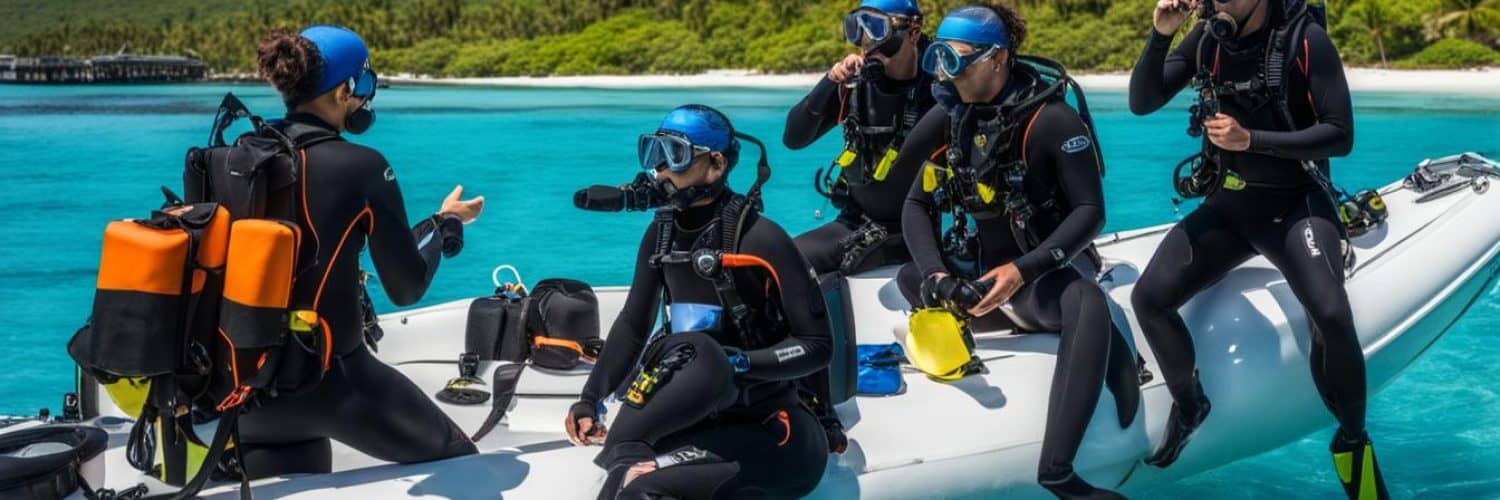Welcome to the fascinating world of scuba diving! If you’ve ever dreamed of exploring the underwater realm, this article is for you. Whether you’re a complete beginner or have some experience, we’ll guide you through the diving basics, provide valuable tips for beginners, and help you start your scuba diving journey on the right fin! So, let’s dive in!
Key Takeaways:
- Learn the diving basics to kickstart your scuba diving adventure.
- Discover essential beginner diving tips to ensure a safe and enjoyable experience.
- Find out what equipment you need to start diving and where to get it.
- Understand the importance of diving lessons for beginners and choose a reputable diving school.
- Stay safe underwater by following diving safety tips.
Why Scuba Certifications Are Required
Scuba diving is a thrilling sport that offers the opportunity to explore the underwater world. However, it is crucial to understand that scuba diving requires specific knowledge, skills, and training. This is why scuba certifications are required for anyone wishing to participate in this exciting activity.
One of the first certifications you can earn as a scuba diver is the Open Water Diver certification. This certification is obtained upon successful completion of the Open Water Diver course, which provides comprehensive training on scuba diving fundamentals.
Obtaining a scuba certification opens up a world of possibilities for underwater exploration. With a certification, you gain access to a wide range of benefits. You can rent dive gear, ensuring you have the necessary equipment to enjoy your diving adventures. You also have the privilege of getting air tank fills, allowing you to explore the depths of the ocean for extended periods. Furthermore, a scuba certification grants you the ability to book scuba diving adventures worldwide, opening doors to some of the most breathtaking dive spots on the planet.
A scuba certification doesn’t just provide practical advantages; it also grants you membership to an exclusive group of underwater explorers. By obtaining this certification, you join a community of like-minded individuals who share your passion for diving and adventure.
It’s essential to note that scuba certifications are not intended to limit your freedom but rather to enhance your safety while diving. Through certification courses, you’ll acquire the necessary knowledge and skills to navigate the underwater world with confidence. You’ll learn about diving protocols, emergency procedures, and how to handle different dive scenarios.
Getting Started with Scuba Diving
Are you ready to embark on an underwater adventure? The first step to becoming a certified scuba diver is enrolling in a scuba diving certification course. These courses are offered by various diving schools and organizations, such as PADI, SSI, and NAUI. They provide the essential training and skills needed to dive safely and confidently.
Choosing the right diving school or center is crucial for a successful diving experience. Reputable schools will have experienced instructors, well-maintained equipment, and comprehensive training programs. Look for schools that are affiliated with recognized diving associations like PADI, SSI, or NAUI, as they adhere to strict safety standards and teaching practices.
“Enrolling in a scuba diving certification course is the first step towards exploring the wonders of the underwater world.” – John Smith, Experienced Scuba Diver
During your scuba diving certification course, you will learn essential skills such as underwater communication, equipment handling, and dive planning. The courses usually consist of both theory and practical sessions, allowing you to apply what you’ve learned in the classroom to real-life diving scenarios.
Remember, scuba diving is a sport that requires proper training and certification. It’s not something you can learn on your own or without proper guidance. By completing a scuba diving certification course, you’ll not only gain the necessary skills to dive safely but also open up a world of exciting dive sites and underwater exploration.
Benefits of Scuba Diving Certification:
- Access to dive shops and rental gear.
- Opportunity to join guided dive trips and excursions.
- Ability to dive internationally at various dive destinations.
- Meet fellow divers and join a community of diving enthusiasts.
- Expand your knowledge of marine life and ecosystems.
Whether you’re a beginner or an experienced snorkeler looking to take your underwater adventures to the next level, getting certified to scuba dive is a fantastic choice. Take the plunge and start your scuba diving journey today!
Choosing the Right Scuba Diving Program
When embarking on your scuba diving journey, it’s crucial to choose the right program that suits your needs and preferences. Whether you’re a beginner looking for a basic diving experience or seeking a more intensive course, there are various options available for you to explore.
Consider Your Time Constraints
Before selecting a scuba diving program, consider your time constraints. Some courses may require a significant time commitment, while others offer more flexible schedules. Evaluate your availability and choose a program that aligns with your lifestyle.
Duration of the Course
The duration of the scuba diving course is another important factor to consider. Beginner scuba diving courses typically range from a few days to a few weeks, depending on the level of certification you are pursuing. If you’re short on time, you may opt for an intensive course that condenses the training period.
Exploring Different Programs
Research different scuba diving programs to determine which one best suits your needs. Look for those specifically designed for beginners, as they provide a solid foundation of knowledge and skills. Reading reviews and testimonials from previous participants can give you insights into the quality and reputation of each program.
“I chose a beginner scuba diving course that offered a comprehensive curriculum and hands-on training. It was the perfect choice for me as a first-time diver, providing a supportive learning environment and knowledgeable instructors.” – Sarah Johnson
Trial Dive
If you’re unsure about committing to a full scuba diving course, consider trying a trial dive. Many diving centers offer trial dives that allow you to experience scuba diving firsthand under the guidance of an instructor. It’s a fantastic way to test the waters and see if scuba diving is the right sport for you.
Cost Considerations
Scuba diving programs vary in cost, depending on factors such as location, course duration, and additional fees. Consider your budget and compare prices among different programs. Remember to factor in any additional expenses, such as equipment rental or certification fees, when evaluating the overall cost.
| Program | Duration | Cost |
|---|---|---|
| Beginner Scuba Diving Course | 3 days | $300 |
| Intensive Scuba Diving Course | 1 week | $600 |
| Trial Dive | 1 day | $100 |
Remember, the cost of the scuba diving program should not be the sole determining factor. It’s essential to assess the overall value, quality of instruction, and the experience you’ll gain from each program.
By carefully considering your time constraints, the duration of the course, exploring different programs, trying a trial dive, and factoring in the cost, you’ll be better equipped to choose the right scuba diving program that aligns with your goals and aspirations.
Requirements for Scuba Diving
Before embarking on your scuba diving adventure, it’s important to understand the requirements to ensure a safe and enjoyable experience. The following are the key requirements for scuba diving:
Age Requirements
Most scuba diving courses are available for individuals aged 8 and above. However, some courses may have specific age restrictions or limitations. It’s important to check with the diving school or organization to determine the age requirements for the specific course you are interested in.
Swimming Ability
While basic swimming ability is recommended for scuba diving, it is not always required. Scuba diving relies more on buoyancy control and breath control rather than traditional swimming strokes. However, having a reasonable level of comfort in the water and the ability to navigate and move underwater can enhance your diving experience.
Poor Eyesight
Individuals with poor eyesight can still enjoy scuba diving. Contact lenses or prescription masks can be used to correct vision underwater, allowing you to see clearly while exploring the underwater world. It’s important to choose the appropriate corrective measures to ensure clear vision and comfort during your dive.
Medical Questionnaire
Prior to participating in a scuba diving course or activity, you will be required to complete a medical questionnaire. This questionnaire helps to assess your overall health and identify any potential medical conditions that may pose risks or limitations to scuba diving. In some cases, consultation with a physician may be required to obtain medical clearance to ensure a safe dive.
By meeting these requirements, you can ensure that you are fully prepared and equipped to embark on your scuba diving adventure. Now that you understand the requirements, let’s dive in and explore the wonders of the underwater world!
Scuba Diving Requirements
| Requirement | Description |
|---|---|
| Age | Most courses available for individuals aged 8 and above. Specific age requirements may apply. |
| Swimming Ability | Basic swimming ability recommended. Not always required as scuba diving focuses more on buoyancy control and breath control. |
| Poor Eyesight | Individuals with poor eyesight can use contact lenses or prescription masks to correct vision underwater. |
| Medical Questionnaire | Completion of a medical questionnaire to assess overall health and identify any potential medical conditions that may impact scuba diving. Consultation with a physician may be required in some cases. |
Safety Skills and Buoyancy Control
When it comes to scuba diving, safety should always be the top priority. That’s why it’s important to develop the necessary skills and knowledge to ensure a safe and enjoyable diving experience. In this section, we’ll explore some essential safety skills and discuss the importance of buoyancy control.
Adding Air to BCD
One of the key skills you’ll learn during scuba diving training is how to add air to your buoyancy control device (BCD). The BCD allows you to control your buoyancy underwater, which is crucial for maintaining stability and depth control throughout your dive. By adding air to the BCD, you can become more buoyant and ascend, or release air to become less buoyant and descend. Mastering this skill will give you greater control over your movements in the water.
Clearing Regulator and Mask
Another important safety skill that divers learn is how to clear a flooded regulator and mask. In the event that water enters your regulator or mask, it’s essential to know how to remove it to ensure proper breathing and visibility. Clearing your regulator involves a series of controlled exhalations and inhalations, while clearing your mask requires a specific technique of tilting your head back and exhaling forcefully through your nose. These skills will enable you to quickly and effectively handle unexpected situations underwater.
In addition to these key safety skills, it’s essential to maintain a calm and focused mindset while diving. Always dive with a buddy, follow the recommended safety guidelines, and be aware of your surroundings at all times. By incorporating these safety skills and practicing proper buoyancy control, you’ll not only enhance your safety but also improve your overall diving experience.
| Key Safety Skills: | Importance: |
|---|---|
| Adding air to BCD | Allows for buoyancy control and stability underwater |
| Clearing regulator and mask | Ensures proper breathing and visibility in case of water entry |
Reacting to Common Scuba Diving Situations
As a beginner scuba diver, it’s important to be prepared for common situations that may arise underwater. Knowing how to react calmly and effectively can make a significant difference in ensuring your safety and enjoyment while diving.
Recovering a Lost Regulator
One common situation you may encounter is losing your regulator. This can happen if it accidentally gets knocked out of your mouth or if it becomes entangled in underwater vegetation. Remember to stay calm and avoid any sudden movements that may dislodge your mask or disrupt your buoyancy. To recover your lost regulator, follow these steps:
- Slowly exhale to clear your mask and regain visibility.
- Use your free hand to locate the regulator hose.
- Retrieve the regulator from its position and carefully bring it back to your mouth.
- Take a slow, deep breath to ensure the regulator is functioning properly.
- Signal to your dive buddy or instructor that you have regained control of your regulator.
Clearing a Flooded Mask
Another common situation is a flooded mask, which can occur if water enters the mask during an improper seal or accidental removal. To clear a flooded mask, follow these steps:
- Hold the top of the mask firmly against your forehead with one hand.
- Look up slightly and exhale through your nose to create pressure inside the mask.
- While exhaling, tilt the bottom of the mask slightly away from your face to allow water to drain.
- Inhale slowly to let air fill the mask and regain visibility.
- Adjust the mask back into a proper position and equalize the pressure in your ears if needed.
Dealing with Leg Cramps
Experiencing leg cramps while scuba diving can be uncomfortable and hinder your ability to swim effectively. If you encounter leg cramps, take the following steps:
- Signal to your dive buddy or instructor that you are experiencing leg cramps.
- Stop swimming and keep your body still to prevent further cramping.
- Gently stretch the affected leg by flexing your foot towards your shin.
- Maintain good buoyancy and avoid excessive kicking until the cramp subsides.
- If necessary, use your arms or other non-cramping leg to continue propulsion.
Handling a Regulator Malfunction
Regulator malfunctions, although rare, can occur during a dive. It’s essential to recognize the signs of a malfunction and take immediate action. If you experience a regulator malfunction, follow these steps:
- Stay calm and signal to your dive buddy or instructor that you are having a regulator issue.
- Retrieve your spare regulator, which is typically secured as a backup.
- Attach the spare regulator to your tank’s alternate air source.
- Take slow and controlled breaths through the spare regulator.
- Ascend to a safe depth and surface with your dive buddy or instructor.
Remember, proper training and practice are essential for handling these common scuba diving situations. By staying calm, following the appropriate steps, and seeking assistance if needed, you can navigate these challenges and continue to enjoy your underwater explorations.
Handling Emergency Situations in Scuba Diving
Scuba diving is a thrilling adventure, but it’s important to be prepared for unexpected emergency situations. Whether you’re a beginner or an experienced diver, knowing how to handle emergencies can mean the difference between life and death. In this section, we’ll explore some common emergency scenarios and essential techniques to ensure your safety.
Running Out of Air
One of the most critical emergency situations in scuba diving is running out of air. It’s crucial to closely monitor your air supply throughout the dive and always keep an eye on your remaining air time. If you find yourself running low on air, stay calm and follow these steps:
- Signal your dive buddy that you need to ascend due to low air.
- Perform a controlled emergency swimming ascent (CESA).
- Make sure to look up and continuously exhale as you ascend to prevent lung over-expansion injuries.
Remember, never hold your breath while ascending.
Using Alternate Air Source
In the event that your primary air supply fails or your buddy experiences an out-of-air situation, it’s crucial to switch to an alternate air source. Follow these steps:
- Signal to your dive buddy that you are going to provide them with your alternate air source.
- Ensure both of you are in a stable position underwater.
- Pass the alternate air source to your buddy, making sure they have a firm grip.
- Monitor your buddy’s breathing and ascend safely to the surface together.
Practicing this skill during training can help you remain calm and react quickly in an emergency.
Controlled Emergency Swimming Ascent (CESA)
A controlled emergency swimming ascent (CESA) is performed when you are separated from your buddy and cannot access their alternate air source. This skill allows you to safely ascend to the surface while conserving your remaining air. Here’s how to perform a CESA:
- Look up and continuously exhale as you start swimming upward.
- Keep your eyes on the surface to maintain your orientation and prevent disorientation.
- Make sure to ascend at a controlled rate, experiencing a maximum ascent speed of 30 feet per minute (9 meters per minute).
- Signal for help or locate a nearby buoyant object to hold onto if needed.
- Performing a safety stop at 15 feet (4.6 meters) for three minutes is recommended to release any excess nitrogen from your body.
Remember, always follow the recommended ascent rate and never skip a safety stop if required.
Being prepared and knowing how to handle emergency situations in scuba diving can make all the difference. By practicing these techniques during training and staying calm under pressure, you’ll be better equipped to address emergencies and enjoy a safe and unforgettable diving experience.
Conclusion
Are you ready to embark on an extraordinary journey into the depths of the ocean? Becoming a certified scuba diver opens up a whole new world of awe-inspiring exploration and adventure. With the right training, skills, and adherence to safety guidelines, you can enjoy the wonders of the underwater world while ensuring your own well-being.
Enrolling in a scuba diving certification course is the first step towards realizing your dream of underwater exploration. Through these courses, you will receive comprehensive training and guidance from reputable diving schools like PADI, SSI, or NAUI. Whether you are just starting or eager to improve your skills, these programs offer a range of courses suitable for divers of all levels.
Once you’ve completed your training and obtained your scuba certification, the breathtaking underwater world awaits you. From vibrant coral reefs teeming with marine life to mysterious shipwrecks and fascinating underwater ecosystems, scuba diving offers endless opportunities to witness the beauty and wonder that lies beneath the surface.
So, gear up, take a deep breath, and dive into a world of endless possibilities. Become a certified scuba diver, embrace the thrill of exploration, and experience the joy of enjoying the underwater world firsthand. Adventure awaits you beneath the waves!
FAQ
What is the first scuba certification you can earn?
The first scuba certification you can earn is called Open Water Diver, which is issued upon successful completion of the Open Water Diver course.
Why are scuba certifications required for scuba diving?
Where can I enroll in a scuba diving certification course?
You can enroll in a scuba diving certification course at various diving schools and organizations such as PADI, SSI, and NAUI. It’s important to choose a reputable diving school or center for your training.
How do I choose the right scuba diving program?
When choosing a scuba diving program, consider factors such as time constraints, duration of the course, and cost. There are different programs available, ranging from beginner courses to more intensive courses. You can also try a trial dive to get a feel for the sport before committing to a full course.
What are the requirements for scuba diving?
The requirements for scuba diving are minimal. Most scuba diving courses are available for individuals aged 8 and above, although some courses may have specific age requirements. Basic swimming ability is recommended but not always required. Individuals with poor eyesight can wear contact lenses or use prescription masks. A medical questionnaire and, in some cases, consultation with a physician may be required to ensure a safe dive.
What safety skills are essential for scuba diving?
Safety skills and buoyancy control are essential for scuba diving. During training, you’ll learn important skills such as adding air to your buoyancy control device (BCD) to control your buoyancy underwater. You’ll also learn how to clear a flooded regulator and mask. These skills ensure your safety and comfort while diving.
How should I react to common scuba diving situations?
As a beginner scuba diver, it’s important to know how to react to common situations that may arise underwater. These include recovering a lost regulator, clearing a flooded mask, dealing with leg cramps, and handling a regulator malfunction. Proper training and practice will help you handle these situations calmly and effectively.
How should I handle emergency situations in scuba diving?
While scuba diving, it’s important to know how to handle emergency situations. This includes running out of air and using an alternate air source from your dive buddy. In the event that your buddy is not immediately close by, you can perform a controlled emergency swimming ascent. These techniques ensure your safety in critical situations.
What should I know about becoming a certified scuba diver?
Congratulations on taking the first step towards becoming a certified scuba diver! By enrolling in a scuba diving certification course, mastering basic skills, and following safety guidelines, you can enjoy the wonders of scuba diving safely and confidently. So get ready to dive into adventure and discover a whole new world beneath the surface!


















Add comment